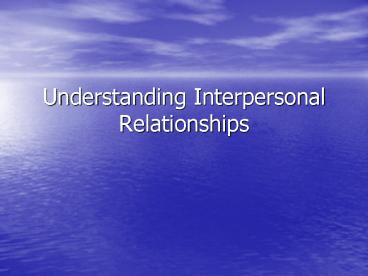Understanding Interpersonal Relationships - PowerPoint PPT Presentation
1 / 19
Title:
Understanding Interpersonal Relationships
Description:
Understanding Interpersonal Relationships What makes communication Interpersonal ? Context: all two-person (dyadic) interaction is interpersonal Quality not ... – PowerPoint PPT presentation
Number of Views:1420
Avg rating:3.0/5.0
Title: Understanding Interpersonal Relationships
1
Understanding Interpersonal Relationships
2
What makes communication Interpersonal?
- Context
- all two-person (dyadic) interaction is
interpersonal - Quality not Quantity is what counts
- Qualitative
- When two people treat each other as unique
individuals regardless of the context - Interpersonal relationship
- When two people meet one anothers social needs
3
Content vs. Relational Messages
- Every verbal msg. contains two kinds of msgs.
- Content
- Focuses on a subject being discussed
- Clean your room, Put gas in the car, Pay the rent
- Relational
- Shows how the parties feel about each other
- Deal with 1 or more social needs
- Inclusion
- Control
- Affection
- Respect
4
Relational Messages contd.
- Relational messages are often conveyed
nonverbally - Remember than nonverbal communication can be
difficult to interpret (ambiguous) - Use Perception checking to clarify meaning
5
Metacommunication
- Metacommunication
- Communication about communication
- Discussing our relationship is metacommunication
- Uses for metacommunication
- It is essential in successful relationships
- Method of solving conflicts constructively
- Shift discussion from content to relational
questions - Relational issues are usually where problems are
found - It sounds like youre angry with me
- I appreciate your honesty with me
6
Intimacy
- Intimacy usually refers to closeness.
- Can appear on different levels
- Physical athletic events, emergencies
- Intellectual exchange of important ideas
- Emotional exchange of important feelings
- Shared activities
7
Intimacy and Gender
- Women value emotional expression as a path to
intimacy. Men value doing things, such as
activities, other than talking.
8
Intimacy and Culture
- Differences in culture can lead to problems in
intimacy in terms of both the need for it and how
to reach it. Different disclosure rates can
impact this variable.
9
Relational Development
- Knapps Developmental Model A ten stage model,
separated into coming together and coming apart
sections, that explains relational development.
10
Ten Stages of Relational Development
- Initiating Making contact with another person
- Experimenting emergence of small-talk
- Intensifying expression of feelings spending
more time together - Integrating Identity as one social unit is
created - Bonding symbolic public gestures to show
commitment
11
Ten Stages of Relational Development, cont.
- 6. Differentiating re-establish individual
identity - 7. Circumscribing shrinking interest and
commitment - 8. Stagnation boredom
- 9. Avoiding when stagnation becomes unpleasant
- 10. Termination ending
12
Characteristics of Relational Development
Maintenance
- Relationships are constantly changing
- Movement is always to a new place
13
Self-Disclosure
- Definition deliberately revealing information
about oneself that is signification and that
would not normally be known to others - Deliberate purposeful
- Significant revealing important information
- Not known to others
14
Self-disclosure
- Reciprocation and development of a relationship
are the most common reasons for self-disclosure
15
Social Penetration Model (Altman Taylor)
- Concerned with two factors that determine the
intimacy of interpersonal relationships - Breadth range of subjects being discussed
- Depth shift from nonrevealing messages to more
personal ones
16
Johari Window(Luft Ingham)
- Four components that make up what one knows about
him/herself and what others know about him or her - Open both you and the other are aware of
- Blind you are unaware, but the other is not
- Hidden you are aware, but arent willing to
share with others - Unknown both you and the other are not unaware
17
Characteristics of Effective Self-disclosure
- Influenced by culture
- Usually occurs in dyads
- Usually symmetrical
- Occurs incrementally
- Large amounts of self-disclosure are usually
unnecessary - Self-disclosure is usually scarce
18
Guidelines for AppropriateSelf-disclosure
- Is the other important?
- Is the risk of disclosing reasonable?
- Are the amount and type of disclosure
appropriate? - Is the disclosure relevant to the situation at
hand? - Is the disclosure reciprocated?
- Will the effect be constructive?
- Is the self-disclosure clear and understandable?
19
Alternatives to self-disclosure
- Lies
- White lies harmless or even helpful
- Equivocation
- Intentionally vague
- Two or more equally plausible meanings
- Hinting
- More direct that equivocal statements
- Get a desired response from others































